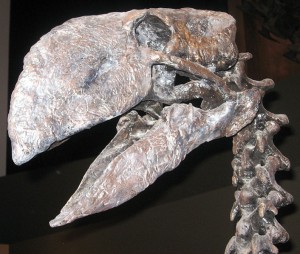Podcast: Play in new window
BOB HIRSHON (host):
A not-so-terrible bird. I’m Bob Hirshon, and this is Science Update.

50 million years ago, a flightless bird as tall as a person – with a beak the size of a human head – roamed North America and Europe. Scientists once thought that the bird, called Gastornis, was a fearsome, meat-eating predator. But a chemical analysis of its bones has revealed that these scary-looking animals weren’t so terrible after all. University of Bonn geochemist Thomas Tuetken led the study.
THOMAS TUETKEN (University of Bonn):
Analyzing calcium isotopes from these fossil bones of this giant bird, in comparison to modern plant and meat eating animals, we come to the conclusion that this is probably not a meat eating giant bird, but more likely was using this giant massive beak to ingest plant matter and not meat.
HIRSHON:
But he says Gastornis probably didn’t have many predators either. That’s because most meat-eating mammals at the time were too small to pose much of a threat. I’m Bob Hirshon, for AAAS, the science society.
